This "Golden Route" of Tibet tour will take you to two cities near Lhasa: Gyantse and Shigatse. Stay overnight at a small town, Gyantse, which is known as the "Heroic City", because it was the site of a major battle during the British invasion in 1904. While there you will also experience Tibetan rural culture. Then visit Tibet's second-largest city Shigatse, which is the most important farming area in Tibet. You will also visit the Tashilhunpo Monastery (the seat of the Panchen Lamas. Inside there is a huge-gilded bronze Buddha statue as well as many other beautiful statues).
Highlights of this tour:
- Climb up the grandiose Potala Palace and visit sacred Buddhist temples and monasteries in Lhasa, such as Jokhang Temple, Drepung Monastery;
- Land travel to Shigatse and enjoy the beautiful landscapes of Tibet and Tibetan rural life on the way;
- Visit the unique Kumba in the mysterious Palcho Monastery and explore the seat of Panchen Lama in Shigatse - Tashilhunpo Monastery.
Tour Brief Information
- Tour price: from $1,119
- Tour code: TD-LST-07
- Tour Type: Private Customizable Tour Package
- Destination: Lhasa / Gyantse / Shigatse / Lhasa
- Duration: 7 days and 6 nights
- Departure: Flexible
- Travel Theme:




- Best Time:




- Physical Level
- Tour Pace
- Max Altitude
5,030m
- Itinerary Details
- Included Services & Fees
- Reviews
- Gallery
- Make an Enquiry
Your tour - at a glance
Day 1 Lhasa Arrival
Day 2~3 Lhasa City Tour
Day 4~6 Lhasa - Gyantse - Shigatse - Lhasa
Day 7 Lhasa Departure
Itinerary Details - Day by Day
Day 1 Lhasa Arrival
Lhasa Airport / Train Station Pick UpWelcome to the roof of the world! You will be picked up by local tour guide at Lhasa airport hall or train station, and then be escorted to check in your hotel in Lhasa city (3,650 m) in a private vehicle. The rest of the day is free for you to explore the local areas and acclimatize yourself to the air, temperature and high altitude of Lhasa.
High Altitude Acclimation Tips: 1) go for some leisure walking to acclimate the high altitude but avoid strenuous activity after arrival; 2) you'd better not have bath, in case of catching a cold; 3) drink more water, and have some fruit; 4) have a good rest...
How to Get to Lhasa: take a domestic flight from other cities like Chengdu, Beijing, Xian, Xining, Kunming, etc. or an international flight from Kathmandu, or take a train from China's other cities, like Chengdu, Xian, Beijing, Chongqing, Shanghai, Guangzhou, Xining, Lanzhou, etc.
-
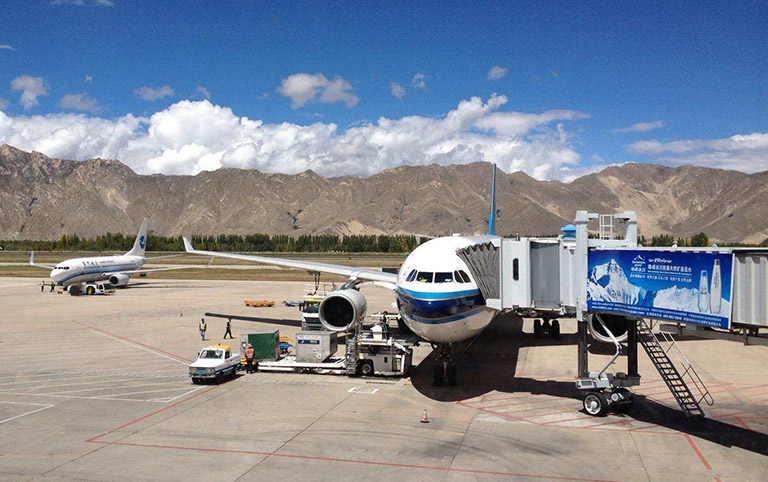 Lhasa Gonggar International Airport
Lhasa Gonggar International Airport
Day 2 Lhasa (B)
Today's Highlights: Norbulingka, Drepung Monastery, Sera MonasteryToday you will visit popular attractions in Lhasa city and suburb to explore Tibetan culture. You will firstly go to visit the beautiful Norbulingka which used to be the former summer palace of Dalai Lamas in the ancient time, and now is a public park. Dotted with various kinds of precious flowers and plants, it is the genuine "Plateau Oxygen Bar". In addition to its magnificent buildings and colorful flowers, Norbulingka also features some big Tibet event activities during big festivals, like Tibetan shows in annual Shoton Festival. Next, drive several kilometers to the western outskirts of Lhasa to visit Drepung Monastery. Drepung, in Tibetan, means "prosperity". Since its establishment, Drepung Monastery has always been one of the most important Buddhist monasteries in Tibet. In its heyday, there were more than 10,000 monks lived and studied in the monastery. Throughout its history, many important and famous Tibetan leaders used to study here, especially the Dalai Lamas. So Drepung Monastery is also respectfully known as the "Mother School of Dalai Lamas". You can also enjoy a panoramic view of Lhasa from Drepung Monastery.
In the afternoon, you will be taken to another famous monastery in Lhasa - Sera Monastery. It is famous for the spectacular "Buddhism Debating". As a daily routine, the monks gather in a courtyard, and debate on the Buddhist doctrines with supplemented gestures, which is thought to be helpful to facilitates better comprehension of the Buddhist philosophy to attain higher levels of study. After enjoying the "Buddhism Debating", you will be transferred back to the city. The rest time is your own free time to rest.
The Etiquette of Visiting Monastery: 1) you shouldn't wear short and uncover shoulders; 2) taking off your sunglasses and hat before entering the chapels; 3) taking photos is usually not allowed inside the chapels.
-
 Chona from Philippines saw Buddhsit scripture debating in Sera Monastery
Chona from Philippines saw Buddhsit scripture debating in Sera Monastery
-
 First Sight of Drepung Monastery
First Sight of Drepung Monastery
-
 Norbulingka Park is a good summer resort in Lhasa
Norbulingka Park is a good summer resort in Lhasa
Day 3 Lhasa Potala Palace Tour (B)
Today's Highlights: Potala Palace, Jokhang Temple, Barkhor StreetStart today's Lhasa exploration with an exciting visit to the landmark - Potala Palace which is the home to the successive Dalai Lama as well as a great masterpiece of Tibetan architecture. The whole palace is divided into the White Palace - living quarters and office to deal with political and Buddhist affairs for Dalai Lamas, and the Red Palace where houses several stupas of previous Dalai Lamas, many historical relics and precious arts. After entering the gate of Potala Palace, you need to walk up about 30 minutes along the zigzag stone paths with white-and-red walls to the White Palace. Remember to ascend the steps slowly and take some stops for sightseeing and rest which will be helpful to reduce high altitude sickness. Then explore the palace in an orderly way from the White Palace to the Red Palace, and exit from the back side. After Potala Palace visit, go to enjoy a leisure stroll in Zongjiao Lukang Park, a lovely park with pleasant scenery built around the lake behind Potala Palace. It is a great place to experience local Tibetans' living styles as you can see local people gathering and chatting, taking exercise, walking the kora, feeding wild birds and ducks, etc. If your day is clear, you can take some great photos of the reflection of Potala Palace on the lake in the park.
Continuing your exploration, you will then get to Jokhang Temple which is considered as the spiritual center of Lhasa and the most revered religious structure of Tibet. In front of Jokhang Temple, you can see crowds of pilgrims polishing the flagstones with their prostration, which is truly a heart-touching scene you will ever see. This temple is also known as the "house of Buddha" because it keeps the precious Jowo Rinpoche, the life-sized (5 foot/1.5m) image of the Shakyamuni at the age of 12. Rise to the top floor of this temple, you can see savor the beautiful golden roof and the view of Potala Palace afar. The last site for today’s exploration is the famous Barkhor Street. It is a circular and wide street encircling the Jokhang Temple. The local people like to walk on the street for several circles usually in the late afternoon as a daily tradition of pilgrimage. The street also has many shops selling a wide variety of traditional Tibetan goods, religious items and handcrafts.
Optional Activity: If your physical strength permits, take a short climb to the viewing-deck of Chakpori Hill to take a panoramic photo of Potala Palace after your Potala Palace visit.
Tips of today: 1) taking photos is not allowed inside the palace; 2) today you will be mainly outside, please bring some water, a hat, sun cream, and sun glasses with you.
-
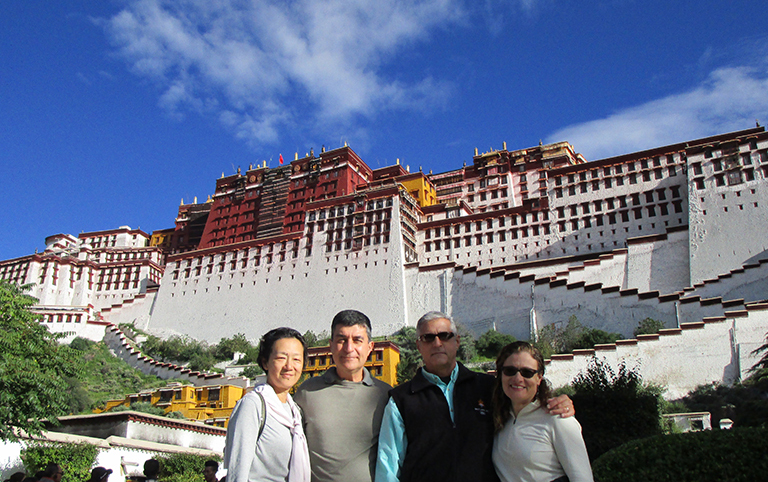 Winnie's family visited Potala Palace with Tibet Discovery
Winnie's family visited Potala Palace with Tibet Discovery
-
 Prayers at Jokhang Temple
Prayers at Jokhang Temple
-
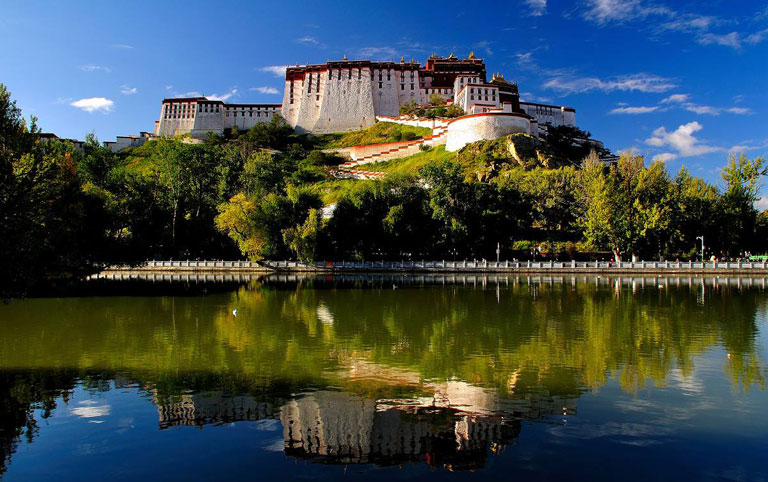 Seeing Potala Palace from Zongjiao Lukang Park
Seeing Potala Palace from Zongjiao Lukang Park
-
 Overview of Barkhor Street
Overview of Barkhor Street
Day 4 Lhasa – Gyantse (B)
Today's Highlights: Yamdrok Lake, Karola Glacier, Palcho Monastery, Gyantse DzongToday you will leave Lhasa and drive about 6.5 hours to Gyantse. The first site you will reach is the holy Yamdrok Lake. As the largest fresh lake in the northern of the Himalaya Mountains, it spreads about 675 square meters from south to north, like an eardrop lying in the arms of snow-capped giant mountains. Viewing from a distance, you can see fertile pastures full of yaks and sheep, and some small Tibetan villages along the lakeshore. Keeping driving not so far from Yamdrok Lake, you will see the imposing Karola Glacier towering aloft on the right side of the road.
Continuing your trip, you will get to the historical city of Gyantse. Feel hungry? Have a good lunch in the town, then go to visit the mysterious Palcho Monastery. The monks and tradition of three important sects of Tibetan Buddhism - Sakyapa, Zhalupa and Gelukpa, peacefully coexist in this monastery. Its Kumbum, which is 35 meters high and has 76 small chapels with hundreds images of Kriyatantras , is believed to be the largest such structure in Tibet. Finishing the visit in Palcho, go to take some photos of the Gyantse Dzong Fortress on which the Tibetan army used to fight against the British army's invasion during the early 20th century. It is a very impressive fortress with typical Tibetan palace architecture style which is inherited from Yumbulagang Palace - The First Palace of Tibet.(Gyantse Dzong Fortress now is closed for maintenance. Tourists cannot climb up to the top, but still can enjoy its magnificent appearance from the square at the foot of the Dzong Hill.)
Tips of today: 1) wear warm clothes to prevent from cold and wild; 2) the road condition from Lhasa to Gyantse via Yamdrok Lake is good; 3 feel free to ask your driver to stop so you can stretch your legs or take some pictures.
-
 Yamdrok Lake is as beautiful as a sapphire
Yamdrok Lake is as beautiful as a sapphire
-
 White Pagoda of Palcho Monastery
White Pagoda of Palcho Monastery
-
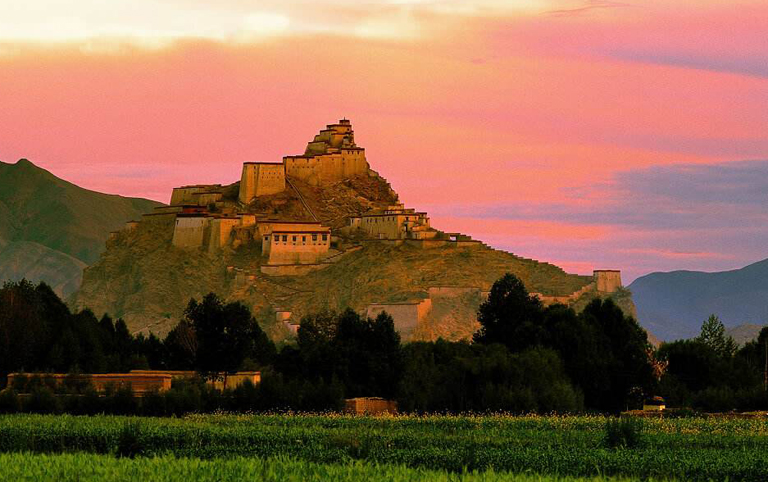 Dzong Fortress in Red Dusk
Dzong Fortress in Red Dusk
Day 5 Gyantse – Shigatse (B)
Today's Highlights: Pala Manor, Tashilhunpo MonasteryAfter breakfast, you will visit a very special site where you can learn about the living condition and tradition of old Tibet - Pala Manor. Located in a Tibetan village about 4km southwest from Gyantse city, Pala Manor is the only aristocratic manor preserved well in Tibet, and used to be the private manor of Pala families since 17th century. The aristocratic and the serfs both lived in the manor but completely different life. The aristocratic didn't need to work, lived in bright, large and luxury rooms, used costly furnitures and imported luxuries, such as OMEGA watch, LV purse, wine, etc. While the serfs lived in dark crude room in yards, got paid little but did all the labouring works. Fortunatly, the house, relics in the rooms are still remain the same as they used to be.
After the visit in Pala Manor, drive about 2.5 hours to Shigatse. After lunch, you will take a visit to the official seat of Panchen Lama - Tashilhunpo Monastery,which is also the largest and most influential Gelug Monastery in Shigatse prefecture. Here you will see a giant statue of Future Buddha, the largest one of its kind on earth ( 26.2 meters high and 11.5 meters wide ), decorated with precious pearls, turquoises, corals and ambers.
Accommodate in Shigatse City.
Tip of today: 1) the road condition is fairly good; 2) obey Buddhist manners and talk appropriately when visiting Tashilhunpo.
-
 Tashilumpo Monastery in Thangka Sunning Festival
Tashilumpo Monastery in Thangka Sunning Festival
-
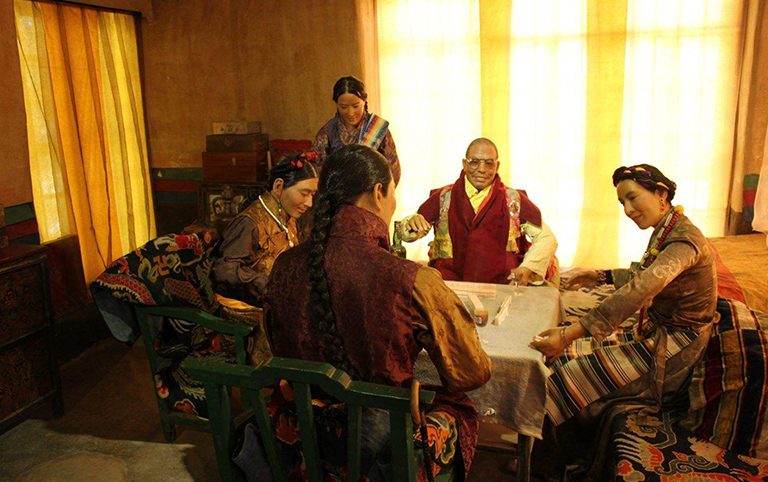 The Nobles in Pala Manor
The Nobles in Pala Manor
-
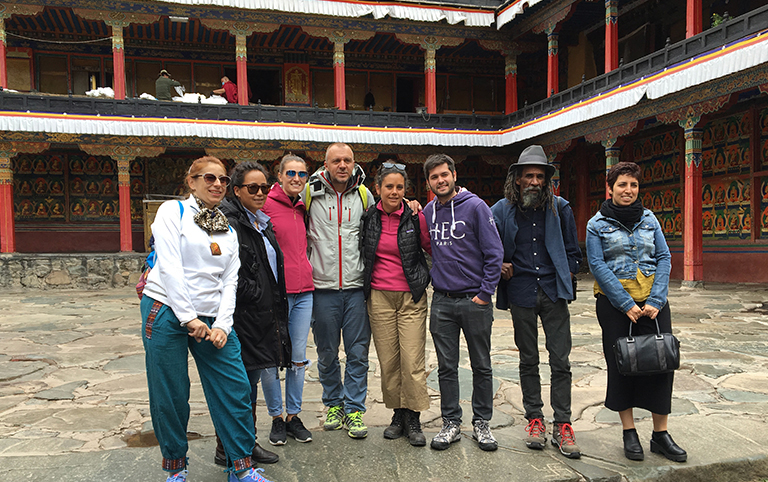 Silvia's group in Tahilhunpo Monastery
Silvia's group in Tahilhunpo Monastery
Day 6 Shigatse – Lhasa (B, D)
Today's Highlights: Nyemo TunbaToday you’ll drive back to Lhasa (5 hours) along the legendary Yaluzangbu River, the mother river of Tibet. On the halfway, you will take a visit to Nyemo Tunba which was the home of Tunmi Sangbuzha who invented the Tibetan character as well as the famous Tibetan Incense. Here in Tunba, you also have chance to witness the process of making Tibetan Incense with water mill. At the same time, the scenery here is fabulous - ancient cypress trees, green willows, murmuring river...
Leave Tunba, keep driving to Lhasa. In the evening, you’ll have a Tibetan-style farewell dinner in a typical Tibetan restaurant, with traditional Tibetan songs and dances.
-
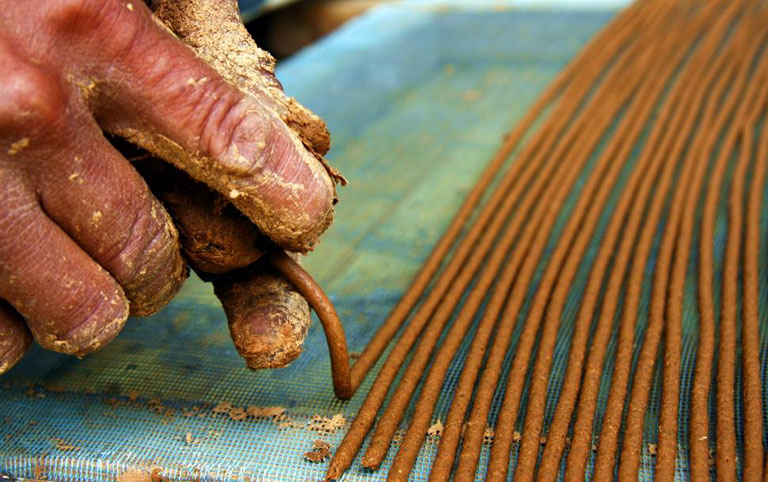 A worker is making Tibetan Incense
A worker is making Tibetan Incense
Day 7 Lhasa Departure (B)
Lhasa Airport or Train Station Dropped OffToday is free for you until your tour guide transfer you to the airport in time for your flight or drop you off at Lhasa train station.
Tips of today: 1) please pack your luggage carefully, especially for small things like camera charger, power adaptor, mobile phone, phone charger, wallet and towel; 2) if your flight is arranged in the afternoon, please make sure you check out the hotel before 12pm.
Useful Trip Notes
-
- 1. Tibet Permits Guaranteed
To travel in Tibet, all Non-Chinese passport holders need to have a Tibet Travel Permit which is issued by Tibet Tourism Bureau in Lhasa. And only Chinese travel agencies like Tibet Discovery can apply for the permit on behalf of tourists. You must obtain it before your tour starting because the permit will be checked when you board your flight/train to Tibet. Traveling with Tibet Discovery, you don't have to worry about the complicated procedures of Tibet Travel Permit application. All you have to do is to confirm a tour package with us and send us your passport and Chinese visa copies at least 15~20 days in advance before your tour, then we will take care of all the rest things. Once the permit is issued, we will deliver to your address in China, such as your hotel, local travel agency, etc.
-
- 2. Available Months to Visit Tibet
Generally speaking, April to October is the best time. July and August are the peak season and rainy season. It is usually snowy and cold in winter, which is not suitable for visit Mount Everest, Namtso and Mount Kailash regions. While other places such as Lhasa, Gyantse and Shigatse are suitable for travel all year around. The temperatures in daytime and night differs a lot, usually 5~15℃ in the daytime and -5~0℃ in the night, so please wear accordingly.
-
- 3. High Altitude Sickness
The average altitude of Tibet is about 4000 meters above the sea level (Lhasa: 3700m; EBC: 5200m; Namtso: 4718m). You may suffer a bit from High Altitude Sickness in the beginning days of your Tibet trip if you haven’t had rich high plateau travel experience. But don’t worry too much, the high altitude can be acclimatized usually in 2~3 days. Our suggestion is to take a physical examination and get suggestions from your doctor, and also bring some medicines to prevent from High Altitude Sickness before your trip. While in Tibet, you should keep warm all the time, avoid strenuous activities, drink more water and eat more vegetables and carbohydrates. You’d better not take showers during the first two days after your arrival in Tibet. If you don’t feel well, get help from your tour guide or go to the hospital without any delay.
-
- 4. How to Go to Tibet
Basically you have two options – flight and train. Currently, you can take a flight to Lhasa from Beijing(4.5hrs), Xian(3.7hrs), Chengdu(2.5hrs), Chongqing(3hrs), Kunming(3hrs), Kathmandu (1.5hrs), etc. Among all these cities, Chengdu and Xian have more frequent flights to Lhasa.
If you prefer a train travel, you can take a train to Tibet from Beijing(40.5hrs), Xian(32hrs), Chengdu(43hrs), Shanghai(47hrs), Chongqing(42hrs), Lanzhou(25hrs), Xining(22hrs), Guangzhou(54hrs). -
- 5. Packing and Wearing Ideas
Firstly you can’t forget your passport and Chinese Visa. A large backpack and a smaller one are recommended (the smaller one can be used for daily activities). Also bring necessary medicine you need. Other stuffs like sunglasses, snow glasses, hats, lip balm, sun block are recommended.
As for wearing, you are suggested to dress in layers (both thin and thick jackets). Down jacket is necessary in Spring and Autumn. A pair of durable and comfortable shoes is necessary.
Recommended Tibet Group Tour Packages
Escorted by a skilled driver and companied by a professional local tour guide to organize all the activities, all you have to do is to enjoy your fantastic Tibet journey.Following are some other recommended Tibet group tour packages that you may be interested in. You can also contact us to customize a trip if you want..
-

Lhasa / Gyantse / Shigatse / Everest / Lhasa
8 Days Lhasa to Mount Everest Private Tour
Highlights: Potala Palace, Yamdrok Lake, Tashilhunpo Monastery, Mt. Everest
-

Lhasa / Gyantse / Shigatse / Lhasa
6 Days Lhasa Gyantse Shigatse Private Tour
Highlights: Potala Palace, Yamdrok Lake, Tashilhunpo Monastery...
-

Lhasa / Shigatse / Mount Everest / Namtso Lake / Lhasa
9 Days Tibet Discovery Tour plus Everest and Namtso Expedition
Highlights: Potala Palace, Yamdrok Lake, Mt. Everest, Namtso Lake
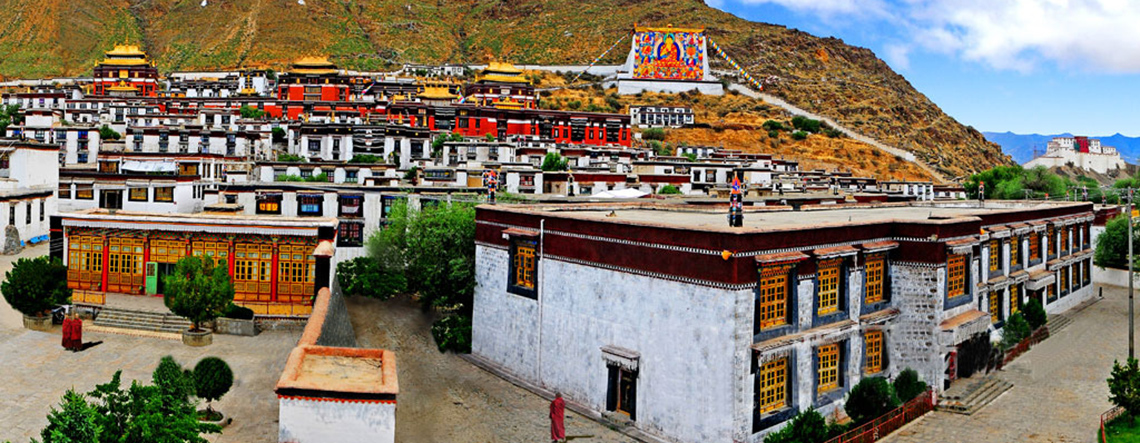
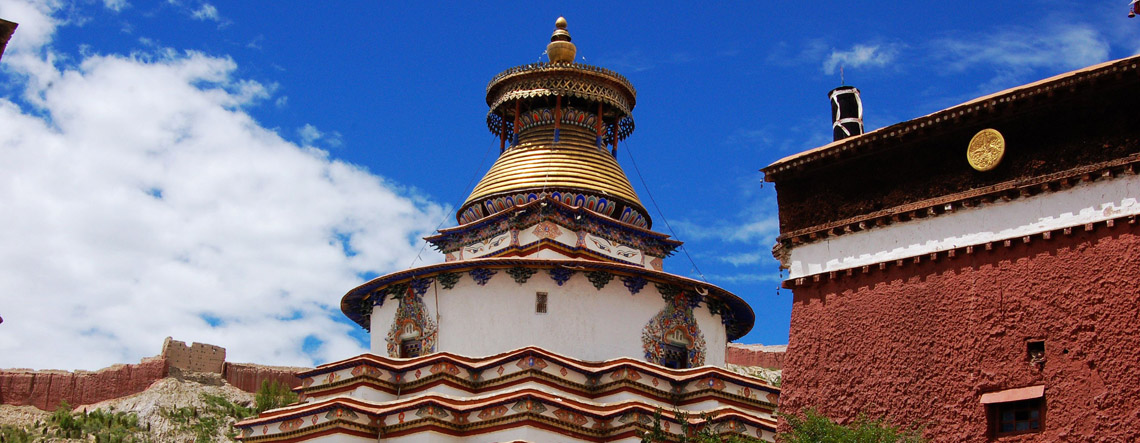
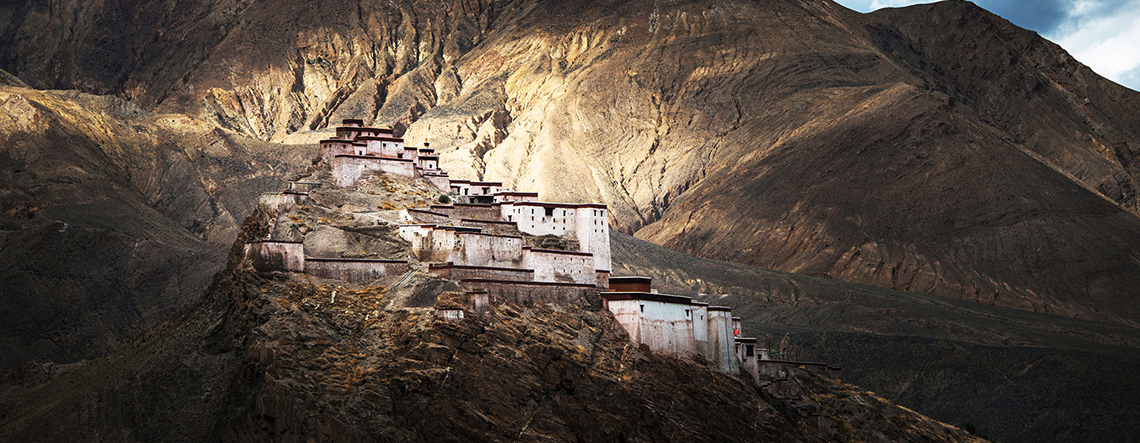
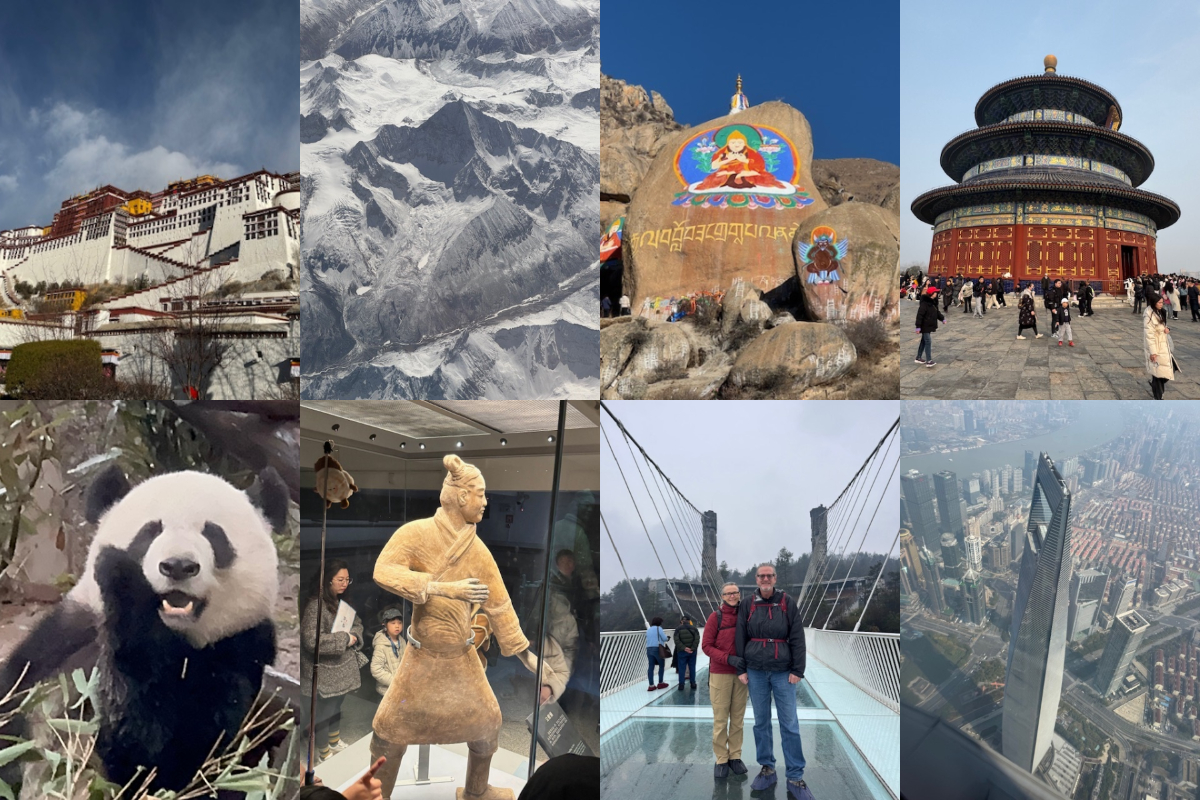

 Karen
Karen Wonder
Wonder Jack
Jack Rita
Rita Johnson
Johnson Vivien
Vivien Wing
Wing Ariel
Ariel Leo
Leo Tracy
Tracy Evelyn
Evelyn April
April Phoebe
Phoebe Kelly
Kelly Shirley
Shirley Reya
Reya Juliet
Juliet Elk
Elk Felix
Felix Sean
Sean